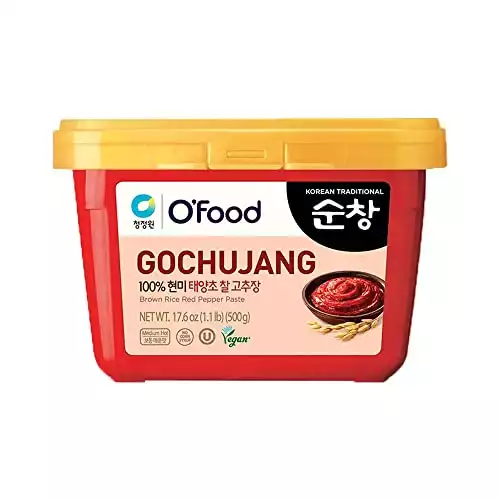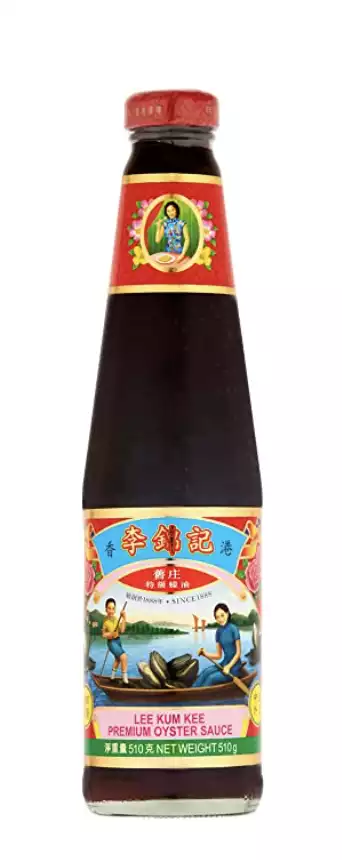The flavor intensity and complexity that characterize Asian cuisine rely heavily on the use of sauces. A high-quality sauce can elevate any dish, bringing a new dimension of taste, aroma, and texture. Therefore, no matter whether you’re looking for a coating, glazing, or dipping sauce, these five delicious Asian spicy sauces are guaranteed to take your home cooking to the next level.
The best Asian spicy sauce overall is sambal oelek, as its piquant-savory flavor profile goes well with almost any dish. The sauce is made using ground chilies, ginger, shallots, garlic, vinegar, and fermented shrimp paste. There are two sambal variations cooked in Southeast Asia: oelek and belacan.
However, there’s no shortage of other equally-delicious options that might fit your needs better:
- If you’re looking for a sauce you can easily find in almost any grocery store and supermarket, go with sriracha.
- If you’re looking for the most versatile sauce, opt for gochujang.
- If you’re looking for a sauce that provides a particularly strong umami flavor, go with oyster sauce.
- If making a decision based on sheer spiciness, chili oil is the way to go.
If you want to learn more about what sets these sauces apart in the rich mosaic that is the Asian spicy sauce assortment, keep reading. Below, I’ll also be discussing some of the most important factors to consider before choosing a spicy sauce that fits your requirements and cooking style best, so make sure to read through the following section if you’re having a particularly hard time deciding.
Factors To Consider
Before diving into my selection of the best Asian spicy sauces to add more flavor to your dishes, it’s important to discuss some most essential factors to consider when choosing a sauce to take your cooking to the next level.
If you’ve had little to no experience with Asian cuisine, you might find choosing between a seemingly endless array of glazes and sauces intimidating and overwhelming. However, with a bit of structure and guidance, I guarantee you’ll be able to find an option that fits your flavor preferences and cooking style perfectly.
The first thing I want to note is that no two types of Asian spicy sauces are the same. The sooner you learn the distinct flavor and quality contrast between different varieties, the better you’ll be able to find the option that best suits your needs.
There are four main factors that should influence your choice of spicy sauce:
- Your heat tolerance
- Flavor
- Ingredient quality
- Price
Let’s take a deeper look into each of these elements.
Your Heat Tolerance
If you’re looking to switch up the flavor and intensity of your dishes, it can be tempting to go for the spiciest sauce you can find right off the bat; however, if you’re new to experimenting with Asian flavors, this is one of the biggest mistakes you can make (and can even put you off the cuisine altogether).
Even those that have some previous experience with Asian food can fail to understand that locals born and raised in the regions where these sauces originate from have grown to build an impressive heat tolerance, which is something you should consider when looking at the heat rating in an authentic sauce. An option that might be regarded as mild by a native Indonesian or Taiwanese won’t necessarily feel the same to you.
Therefore, before choosing a sauce, you should be realistic about your heat tolerance. This will not only allow you to select a variety that adds to your dishes rather than taking away from them, but it will also help you find the right quantities and ratios much quicker. Certain sauces can make your eyes water as soon as they hit your tongue, so make sure to do a (small) taste test before adding a specific amount to a dish (even if that amount is called for in a recipe).
Identifying how spicy or potent a sauce really is can be easier than you think. First of all, in most cases, you’ll find a rating printed right on the label (e.g., some brands will classify their sauces as mild, medium, hot, or very hot). However, these ratings can be a bit subjective if you’ve never tried any other product of that specific brand before.
Therefore, (arguably) the best way to determine the spiciness level of a particular sauce is to see where it stands on the Scoville scale. This scale ranks all pepper and extract varieties based on Scoville Heat Units, which are used to indicate spiciness level.
The scale features a wide range of pepper varieties, some of which you might’ve already had. Therefore, all that’s left to do is scour the ingredient list of a particular sauce and compare the rating of the pepper (or extract) used in said sauce with a variety you’ve already tried to gauge whether you can handle the heat or not.
Flavor
A spicy sauce adds much more than just heat to a dish; it adds intensity, complexity, and, most importantly, flavor. This is yet another reason why you should always choose an option whose heat level you know you can handle, as the point of these sauces is to make a meal more enjoyable, not simply burn the roof of your mouth.
One of the most important factors to consider when choosing an Asian spicy sauce is the type of flavor you’re looking to add to your cooking. Each country boasts different culinary cultures and flavor combinations, which is why a bit of research might be needed to determine which would fit your cooking style and preferences best.
An easier approach would be to try to match the origin of a sauce with the origin of the dish you’re cooking. Even though a particular brand might not be exactly what a recipe calls for, the ingredients, flavors, and spices usually used within a culture are meticulously chosen to complement each other.
Therefore, as long as you choose a blend that fits the cultural background of your dish, chances are the end product will taste as rich and complex as you were hoping it would.
Ingredient Quality
As with anything else food-related, ingredient quality can make or break the taste and enjoyability of the final product. This can be especially important if you’re someone with specific preferences or dietary restrictions, which is yet another reason why reading the label is a must when it comes to picking a new spicy sauce to add to your collection.
For example, a few factors many consumers would like to look out for include:
- Whether a particular brand or variety is vegan/vegetarian.
- Whether the option you’re choosing is organic.
- Whether there are any artificial sweeteners or colorings in the ingredient list.
If you’re someone trying out a particular sauce variety for the first time or an occasional spicy sauce user simply looking to add a bit of punch to their cooking, opting for a run-of-the-mill big name brand that you find in most supermarkets might be the best choice for you.
However, if you’re someone who’s well-versed in Asian cuisine and looking to enjoy an authentic experience, you might have better luck shopping in artisan stores or getting your spicy sauce delivered from overseas by purchasing it online.
Price
Last but not least, when choosing a spicy Asian sauce, it’s essential to consider your budget. Some higher-end, 100% authentic varieties can cost you a pretty penny, especially if directly shipped from overseas or artisanally made.
Therefore, never blindly assume that a brand or type of sauce will be within your budget and do adequate research instead. In the same vein, you’ll want to determine the value that each option provides.
For example, a cheaper alternative that doesn’t add much to a dish is ultimately a waste of money, forcing you to make another purchase and overall leading to increased costs in the long run.
While we’re on this topic, it’s essential to keep in mind that while more expensive doesn’t always mean higher quality, when it comes to sauces, you generally get what you pay for. If you’re looking for a brand that provides 100% authentic, naturally made Asian spicy sauce that features premium-quality ingredients, be ready to spend a bit extra.
Now that we’ve gotten the factors you want to be looking for out of the way, it’s time to delve into some of my personal favorite spicy Asian sauces of all time. All of the options and brands I’ll be mentioning (and linking) below are guaranteed to provide an impressive amount of flavor and intensity to any dish you incorporate them into.
Regardless of your preferences or budget, you’re bound to find a winner between the following alternatives.
Best Overall: Huey Fong Sambal Oelek
Sambal Oelek is a staple condiment of Indonesian descent that beautifully balances spicy, savory, and sweet. Even though there are two sambal variations (belacan and oelek), the latter is undoubtedly the most versatile, enhancing the flavor of a wide range of dishes, from succulent braised meats to colorful stir-fries.
Therefore, if you’re looking to expand your palate while adding a bit of complexity and flavor to your dishes, a few dashes of sambal oelek should do the trick. Its ingredients include:
- Chili peppers
- Salt
- Vinegar
- Ginger
- Shallots
- Garlic
- Fermented shrimp paste
Therefore, even though the sauce carries a unique punch you might have never tried before, it’s still familiar and versatile enough to go with a wide range of flavors and ingredients.
Sambal oelek usually comes in two forms – sauce or paste; however, regardless of the variety you choose, you’ll still get the same signature spicy yet tangy quality that’s hard to find elsewhere (just be mindful of ratios and quantities if you’re using paste instead of sauce).
I’ve rated sambal oelek as the best spicy Asian sauce because the level of flavor and complexity it brings to a dish while still feeling familiar and hearty is remarkable. Therefore, I’d say that this sauce is an excellent option for novice cooks and professionals alike, as it’s bound to expand your palate regardless of your experience level.
As I briefly mentioned, one of the best aspects of having a bottle of sambal oelek at your disposal is its versatility. Its uses are virtually endless, you can use it on dishes of all origins and backgrounds, and it can take on many forms.
For example, you can use it as a
However, I want to note that sambal oelek is quite a strong-tasting sauce (if the ingredient list didn’t tip you off already). As you’ll better understand while reading through the rest of this list, Asian cuisine doesn’t rely on mild unoffending flavors. The cuisine features bold, intense tastes and aromas, which is something to keep in mind when purchasing a bottle of sambal oelek.
If you ever use this sauce, make sure to experiment with smaller quantities first; after all, you can always add more! Such a strong-flavored sauce can quickly overpower milder-tasting ingredients on a dish, so add as you go and taste to see whether any adjustments need to be made. When it comes to sauces and seasonings, it’s always better to experiment and cater to your preferences rather than blindly follow a recipe.
Most Accessible: Huy Fong Sriracha
You can consider sriracha a milder, more accessible version of sambal oelek; however, I doubt sriracha needs an introduction, considering that it’s the most popular hot sauce in the US. There’s a reason why Americans (and many others) can’t seem to get enough of this condiment. It’s spicy without being overpowering, and it adds a pleasant zesty flavor to any dish it’s in.
If you’re not ready to invest in a bottle of sambal oelek, or you’re unsure of how well you’d handle its heat, trying sriracha first is an excellent solution. The sauce is available virtually anywhere, meaning you’ll likely be able to find it in any of your local supermarkets or grocery stores.
Moreover, sriracha’s spiciness is still far less overpowering compared to other options on this list, so if you’re trying your hand at spicy Asian dishes for the first time, experimenting with sriracha is the way to go.
Similar to sambal oelek, sriracha comprises sun-ripened chilies, salt, garlic, and vinegar. However, unlike the former, the latter doesn’t feature the sometimes controversial shrimp paste, which is why its taste and aroma are much more versatile and easy to incorporate into a broader range of dishes.
As sriracha gains global popularity, its uses have extended far beyond Asian cuisine, which comes as no surprise as the condiment is able to enhance the flavor of any dish it’s in, regardless of its origin. The sharp, zesty yet slightly sweet taste and aroma carry a punch without overpowering milder ingredients.
Therefore, I highly recommend experimenting with sriracha until you discover the combinations and ratios in which you enjoy it the most. The possibilities are virtually endless – you can use the sauce as a marinade, glaze, or dipping sauce for almost any savory (or sometimes even sweet) meal you can think of.
Most Versatile: Chung Jung One Gochujang
Gochujang is one of Korea’s finest exports – a red, thick, sweet, and spicy paste that’s bound to leave you asking for seconds. Its ingredients include:
- Fermented soybean paste
- Sticky rice
- Salt
- Spices
- Powdered chili
Therefore, you know that gochujang will deliver a powerful, unique umami flavor to any dish it’s in (along with plenty of
Even though the condiment is most popularly used in traditional dishes such as Korean barbecue and bibimbap, its range of uses is really remarkable, which is why if you’re looking for a versatile sauce that can go with almost any type of dish or ingredient, gochujang is the way to go.
Through a mere tablespoon of the stuff, you’ll be adding an impressive amount of spiciness, smokiness, and sweetness to a dish, taking its flavor intensity to the next level. It doesn’t matter if you’re looking to impress your loved ones with your slowly-braised meats, fresh salads, or simmered rice cakes; adding even the slightest bit of gochujang paste to the mixture is guaranteed to do the trick.
The consignment provides remarkable depth to any dish through its earthy, almost meaty undertones. Not to mention the spicy-sweet-savory balance is to die for and something I genuinely believe any foodie should experience at least once in their lifetime.
Luckily, gochujang is also relatively accessible (albeit not as much as sriracha), so if your area has a supermarket with a big enough “Asian foods” section, chances are you’ll be able to find it. If not, you can always follow the link embedded above.
Therefore, if versatility is what you’re after, get your hands on some gochujang paste and start experimenting! You can start small by adding the condiment to dishes you already know and love. Once you taste the difference, I can assure you you won’t be able to get enough of it.
Strongest Umami Flavor: Lee Kum Kee Oyster Sauce
Asian cuisine has historically relied on a strong umami flavor to deliver a level of taste and intensity that no other cuisine could. Therefore, if you’re specifically looking for a condiment to provide that umami touch, there’s no better choice than oyster sauce.
It’s hard to say where oyster sauce first originated, as it’s been a favorite all across Asia for centuries now, and it’s easy to see why. The distinct tanginess and smokiness that you get along with the spicy-sweet flavor it’s something that’s hard to find in other similar soy-based condiments.
If you tend to find soy sauce overpowering, don’t worry. Oyster sauce is a much milder alternative that still adds saltiness to a dish without sending it over the edge. Some even say that the condiment works similarly to MSG in that it enhances flavor and aroma in such a way that it’s hard to pinpoint why or how.
Oyster sauce is yet another highly versatile condiment that can be incorporated into a wide range of dishes. You can use it in almost any mouthwatering marinade, glaze, or dipping sauce; however, most cooks like to simply drizzle it over stir-fried chicken – the sauce will highlight any seasoning you used on the meat itself rather than overpower its delicate flavor.
If you enjoy the overall premise of soy sauce but can’t get on board with its intensity or saltiness, I highly recommend giving oyster sauce a try. You’d be surprised at the difference just a splash or two of the stuff can make to a dish.
The condiment also does wonders when it comes to canceling out intense aromas that you don’t want to feel overpowering, such as fish paste or garlic. However, I’m still just scratching the surface when it comes to oyster sauce uses, so make sure to experiment and find out for yourself how you like the condiment to be incorporated into your cooking style.
Spiciest: Hokan Hot Chili Oil
By now, you’ve seen several spicy Asian sauces ranked based on taste, accessibility, versatility, umami flavor, and other similar criteria. However, sometimes what you’re looking for in a spicy sauce is, well,
If a flaming hot condiment is what you’re after, the right type of chili oil should do the trick. Now, I should note that not all kinds of chili oil are made the same, so the taste and intensity can vary depending on the specific brand you purchase.
However, the option I linked above is perfect for those looking to supply their dishes with that extra bit of heat. This type of condiment beautifully pairs with milder-tasting ingredients, deepening their flavors and providing some much-needed intensity.
The origins of chili oil are still a bit unclear, as the condiment comes in several variations that are widely used all across Asia (and elsewhere). It’s easy to understand why chili oil is so popular – a condiment that requires little to no preparation but provides a powerful kick to any dish it graces; as a cook, you can’t really ask for more.
Key Takeaways
Asian cuisine features a wide range of potent yet beautifully balanced spicy sauces that can add flavor and complexity to any dish they’re in. However, before choosing the option that fits your needs and cooking style best, you’ll want to account for some important factors first: your heat tolerance, flavor, ingredient quality, and price.
Sources
- Parade: The Best Asian Condiments, Sauces & Spices According to Chefs
- Taste of Home: 12 Asian Sauces (Besides Sriracha) to Keep in Your Pantry
- Hot Sauce: Scoville Hot Sauce Heat Scale
- Eat This: The #1 Most Popular Hot Sauce in America, According to New Data
- Brit + Co: 18 Times We Got the *Hots* for Sriracha Sweets










